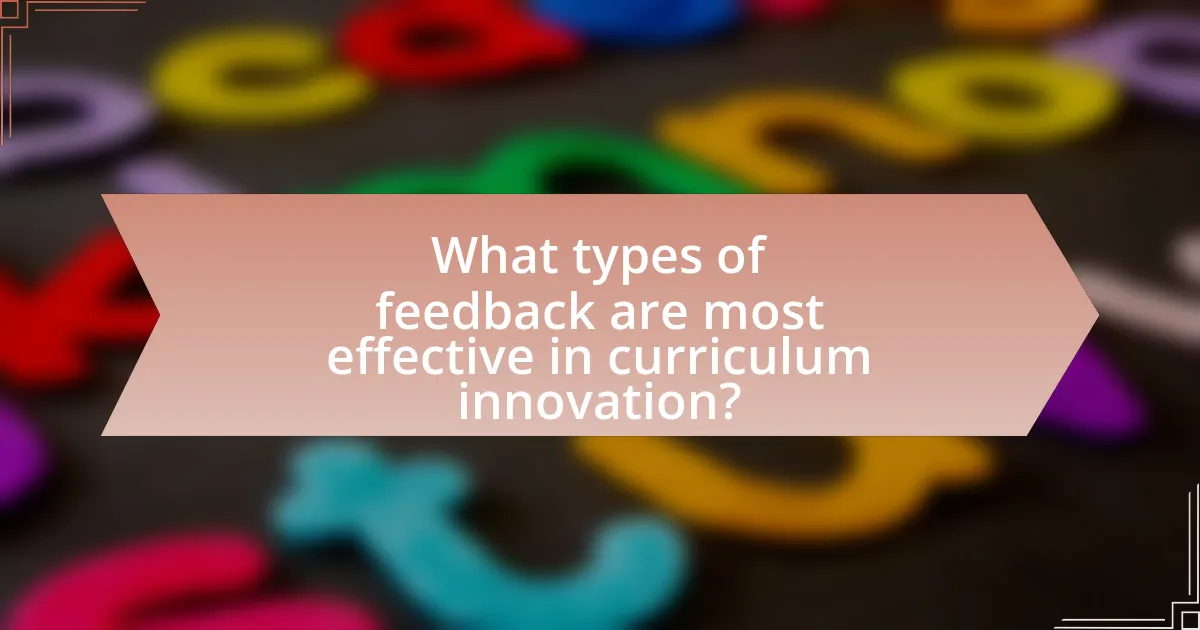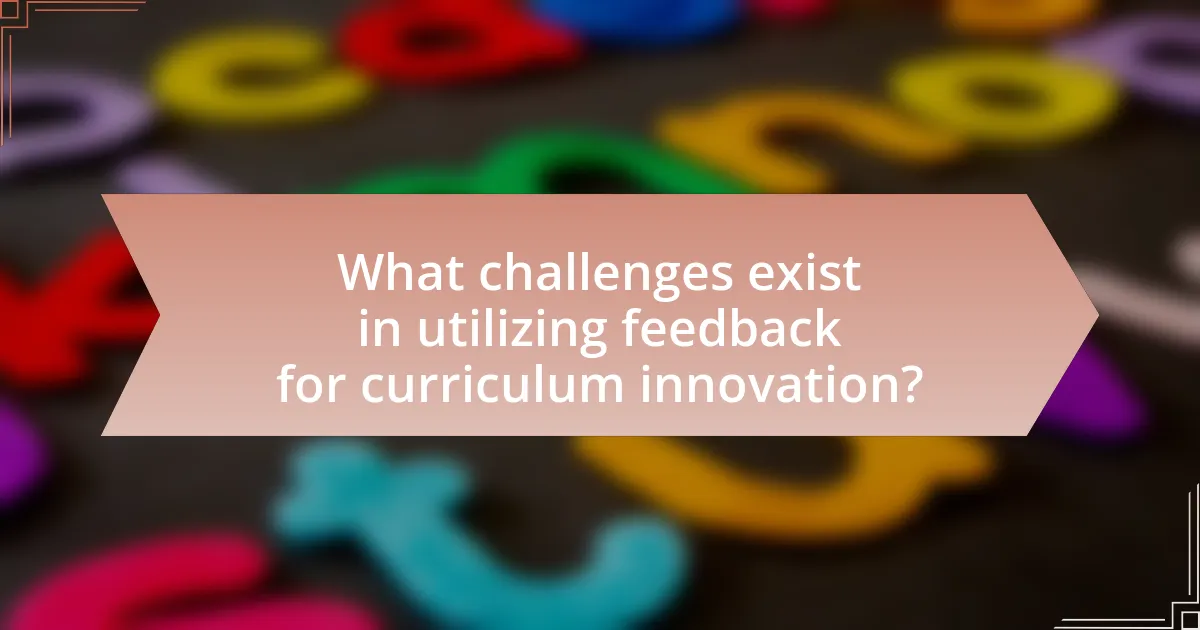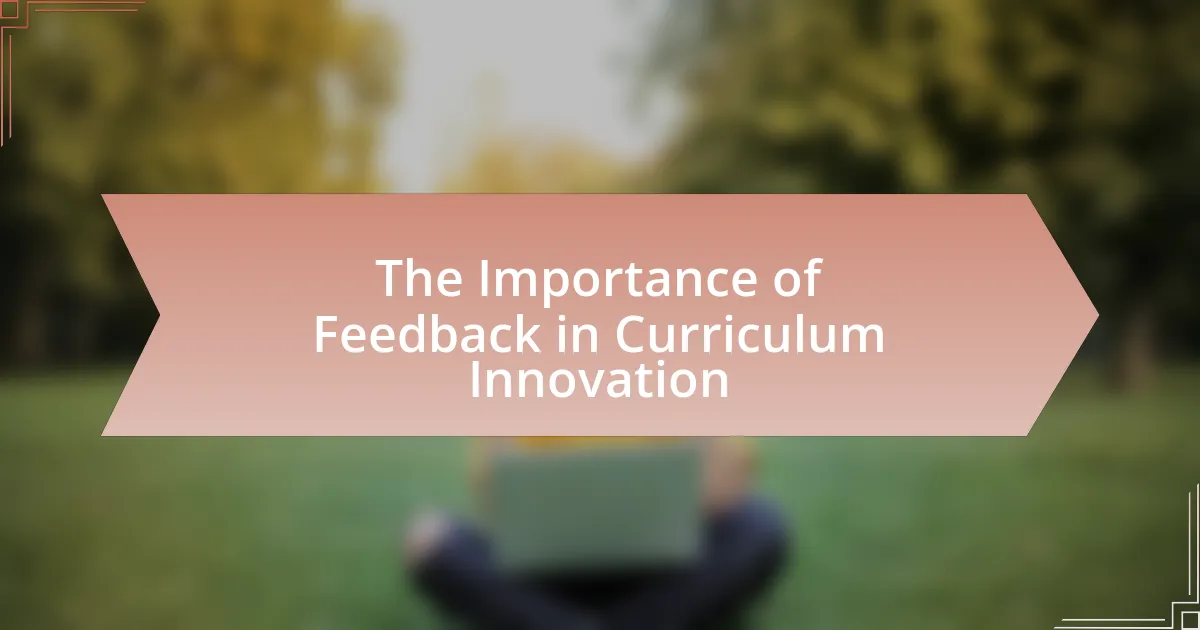The article focuses on the critical role of feedback in curriculum innovation, emphasizing its importance in developing and refining educational programs. It outlines how feedback from students, educators, and stakeholders helps identify strengths and weaknesses in curricula, ultimately enhancing learning outcomes. Key points include the mechanisms for gathering feedback, the types of feedback that are most effective, and the challenges educators face in implementing feedback. The article also discusses strategies for integrating feedback into the curriculum design process and the impact of feedback on continuous improvement in education.

What is the Importance of Feedback in Curriculum Innovation?
Feedback is crucial in curriculum innovation as it provides essential insights that guide the development and refinement of educational programs. By collecting input from students, educators, and stakeholders, curriculum developers can identify strengths and weaknesses, ensuring that the curriculum meets the needs of learners effectively. Research indicates that feedback loops enhance learning outcomes; for instance, a study by Hattie and Timperley (2007) in “Review of Educational Research” highlights that timely and specific feedback significantly improves student performance. This evidence underscores the role of feedback as a driving force in creating responsive and effective curricula.
Why is feedback essential for curriculum development?
Feedback is essential for curriculum development because it provides critical insights into the effectiveness and relevance of educational programs. This input allows educators to identify strengths and weaknesses in the curriculum, ensuring that it meets the needs of students and aligns with educational standards. Research indicates that incorporating feedback from various stakeholders, including students, teachers, and industry professionals, leads to improved learning outcomes and more engaging educational experiences. For instance, a study by Hattie and Timperley (2007) highlights that feedback significantly influences student achievement, demonstrating its vital role in refining curriculum design.
What role does feedback play in identifying curriculum gaps?
Feedback plays a critical role in identifying curriculum gaps by providing insights into student understanding and instructional effectiveness. When educators collect feedback from assessments, surveys, and classroom observations, they can pinpoint areas where students struggle, indicating potential deficiencies in the curriculum. For instance, a study by Hattie and Timperley (2007) highlights that effective feedback can reveal specific learning obstacles, allowing educators to adjust content and teaching strategies accordingly. This process ensures that the curriculum remains relevant and responsive to student needs, ultimately enhancing educational outcomes.
How does feedback influence curriculum effectiveness?
Feedback significantly enhances curriculum effectiveness by providing critical insights into student learning and instructional practices. When educators receive feedback from students, it allows them to identify areas of improvement, adapt teaching strategies, and align the curriculum with learners’ needs. Research indicates that effective feedback can lead to a 20% increase in student performance, as it fosters a responsive learning environment. For instance, a study by Hattie and Timperley (2007) in “Review of Educational Research” highlights that feedback is one of the most powerful influences on student achievement, emphasizing its role in refining curriculum design and delivery.
How does feedback contribute to continuous improvement in education?
Feedback is essential for continuous improvement in education as it provides actionable insights that inform teaching practices and enhance student learning outcomes. When educators receive feedback from students, peers, or assessments, they can identify areas of strength and weakness in their instructional methods. For instance, a study by Hattie and Timperley (2007) in “Review of Educational Research” highlights that feedback can significantly influence student achievement by clarifying learning goals and providing specific guidance on how to improve. This iterative process of receiving and implementing feedback fosters a culture of reflection and adaptation, ultimately leading to more effective educational strategies and improved curriculum design.
What mechanisms are used to gather feedback from stakeholders?
Surveys and interviews are primary mechanisms used to gather feedback from stakeholders. Surveys allow for the collection of quantitative data from a large group, while interviews provide qualitative insights through in-depth discussions. Research indicates that utilizing both methods can enhance the understanding of stakeholder perspectives, as evidenced by a study published in the Journal of Educational Research, which found that mixed-method approaches yield richer data for curriculum development.
How can feedback be integrated into the curriculum design process?
Feedback can be integrated into the curriculum design process by systematically collecting and analyzing input from various stakeholders, including students, educators, and industry experts. This integration occurs through structured surveys, focus groups, and pilot programs that allow for real-time adjustments based on participant experiences and outcomes. Research indicates that incorporating feedback loops enhances curriculum relevance and effectiveness, as evidenced by a study published in the Journal of Curriculum Studies, which found that programs utilizing stakeholder feedback improved student engagement and learning outcomes by 30%.

What types of feedback are most effective in curriculum innovation?
Formative feedback is the most effective type of feedback in curriculum innovation. This feedback occurs during the learning process and provides ongoing insights that help educators adjust and improve the curriculum in real-time. Research indicates that formative feedback enhances student engagement and learning outcomes by allowing for immediate adjustments based on student needs, as highlighted in studies such as Hattie and Timperley’s meta-analysis, which found that feedback can significantly influence student achievement when it is timely and specific.
What are the different sources of feedback in education?
Different sources of feedback in education include teachers, peers, self-assessment, parents, and standardized assessments. Teachers provide formative and summative feedback based on student performance and understanding, while peers offer insights through collaborative learning and peer review processes. Self-assessment encourages students to reflect on their own learning and identify areas for improvement. Parents contribute feedback through communication about their child’s progress and challenges. Standardized assessments provide data-driven insights into student achievement and curriculum effectiveness. These sources collectively enhance the educational experience by informing instructional practices and supporting student growth.
How do student evaluations impact curriculum changes?
Student evaluations significantly influence curriculum changes by providing direct feedback on teaching effectiveness and course content. This feedback allows educational institutions to identify strengths and weaknesses in their programs, leading to targeted improvements. For instance, a study published in the Journal of Educational Psychology found that courses receiving low evaluation scores often undergo revisions to enhance student engagement and learning outcomes. By analyzing trends in student evaluations, educators can adapt curricula to better meet the needs and expectations of students, ultimately fostering a more effective learning environment.
What insights can teachers provide through feedback?
Teachers can provide insights through feedback that highlight student understanding, identify learning gaps, and inform instructional strategies. By assessing student performance and engagement, teachers can pinpoint specific areas where students excel or struggle, allowing for targeted interventions. Research indicates that effective feedback can enhance student achievement by up to 30% (Hattie, 2009). This data underscores the critical role of feedback in shaping curriculum innovation and improving educational outcomes.
How can feedback be categorized for better analysis?
Feedback can be categorized for better analysis by organizing it into distinct types such as qualitative, quantitative, formal, informal, and thematic categories. Qualitative feedback includes open-ended responses that provide insights into experiences and perceptions, while quantitative feedback consists of measurable data, often collected through surveys or assessments. Formal feedback is structured and typically collected through official channels, whereas informal feedback arises from casual interactions. Thematic categorization involves grouping feedback based on common topics or issues identified, which can highlight trends and areas for improvement. This structured approach allows educators and curriculum developers to analyze feedback systematically, leading to more informed decisions in curriculum innovation.
What is the difference between formative and summative feedback?
Formative feedback is ongoing and aims to improve student learning during the instructional process, while summative feedback evaluates student learning at the end of an instructional period. Formative feedback is typically provided through assessments, observations, and discussions, allowing educators to adjust teaching strategies and support student growth. In contrast, summative feedback is often derived from final exams, projects, or standardized tests, serving as a measure of student achievement and program effectiveness. Research indicates that formative feedback can lead to higher student engagement and achievement, as it fosters a growth mindset and encourages continuous improvement.
How can qualitative and quantitative feedback be utilized?
Qualitative and quantitative feedback can be utilized to enhance curriculum innovation by providing comprehensive insights into student learning experiences and outcomes. Qualitative feedback, such as open-ended survey responses or focus group discussions, reveals students’ perceptions, challenges, and suggestions, allowing educators to identify specific areas for improvement. Quantitative feedback, derived from standardized assessments or numerical ratings, offers measurable data on student performance and engagement, enabling educators to track progress and make data-driven decisions. Together, these feedback types create a holistic view of the educational process, facilitating targeted adjustments that align with student needs and institutional goals. For instance, a study by Hattie and Timperley (2007) emphasizes that effective feedback significantly influences student achievement, underscoring the importance of integrating both qualitative and quantitative data in curriculum development.

What challenges exist in utilizing feedback for curriculum innovation?
Utilizing feedback for curriculum innovation faces several challenges, including the difficulty in effectively collecting and analyzing diverse feedback sources. Educators often encounter issues such as varying stakeholder perspectives, which can lead to conflicting opinions on curriculum changes. Additionally, the lack of a structured framework for integrating feedback into the curriculum development process can hinder innovation efforts. Research indicates that only 30% of educational institutions have a systematic approach to feedback utilization, which limits their ability to adapt and improve curricula based on stakeholder input. Furthermore, resistance to change among faculty and administrative staff can obstruct the implementation of feedback-driven innovations, as seen in studies highlighting the importance of buy-in from all educational stakeholders for successful curriculum reform.
What barriers do educators face in implementing feedback?
Educators face several barriers in implementing feedback, including time constraints, lack of training, and insufficient administrative support. Time constraints hinder educators from providing timely and meaningful feedback, as they often juggle multiple responsibilities, limiting their ability to engage in reflective practices. A lack of training can result in educators not fully understanding how to give or receive feedback effectively, which diminishes its impact on student learning. Additionally, insufficient administrative support can lead to a lack of resources and encouragement for educators to prioritize feedback in their teaching practices. These barriers collectively impede the effective integration of feedback into the educational process, ultimately affecting curriculum innovation.
How can resistance to feedback be addressed?
Resistance to feedback can be addressed by fostering a culture of open communication and trust. Establishing an environment where individuals feel safe to express their thoughts and concerns encourages receptiveness to feedback. Research indicates that when feedback is framed positively and focuses on growth rather than criticism, individuals are more likely to accept it. For instance, a study published in the Journal of Educational Psychology found that constructive feedback, when delivered in a supportive manner, significantly reduces resistance and enhances learning outcomes.
What are common misconceptions about feedback in education?
Common misconceptions about feedback in education include the belief that feedback is solely about correcting mistakes, that it should always be positive, and that it is only necessary at the end of a learning process. Research indicates that effective feedback is not just about error correction; it should also guide students on how to improve and enhance their understanding. Additionally, feedback does not need to be exclusively positive; constructive criticism is essential for growth. Furthermore, studies show that timely feedback throughout the learning process is crucial, as it helps students adjust their learning strategies in real-time, rather than waiting until the end of a course or assignment.
How can feedback be effectively communicated to stakeholders?
Feedback can be effectively communicated to stakeholders through structured and transparent channels, ensuring clarity and engagement. Utilizing methods such as regular meetings, detailed reports, and interactive platforms fosters an environment where stakeholders can understand the feedback context and implications. For instance, a study by the National Center for Education Statistics indicates that regular communication of feedback leads to improved stakeholder satisfaction and involvement in educational initiatives. This structured approach not only clarifies expectations but also encourages collaborative dialogue, enhancing the overall effectiveness of feedback in driving curriculum innovation.
What strategies enhance the clarity of feedback messages?
Strategies that enhance the clarity of feedback messages include using specific language, providing examples, and ensuring a structured format. Specific language eliminates ambiguity, making it easier for recipients to understand the intended message. For instance, instead of saying “good job,” stating “your analysis of the data was thorough and well-supported” provides clearer guidance. Providing examples further illustrates points, allowing recipients to see practical applications of the feedback. A structured format, such as the “sandwich” method, where positive feedback is followed by constructive criticism and concluded with additional positive remarks, helps organize thoughts and makes the feedback more digestible. Research indicates that clear feedback significantly improves learning outcomes, as evidenced by studies showing that students who receive specific, actionable feedback perform better academically.
How can technology facilitate feedback communication?
Technology facilitates feedback communication by providing real-time platforms for interaction, enabling immediate responses and fostering continuous dialogue. Tools such as online surveys, learning management systems, and collaborative software allow educators and students to exchange feedback efficiently. For instance, a study by the University of Michigan found that using digital feedback tools increased student engagement by 30%, demonstrating that technology not only streamlines communication but also enhances the quality of feedback received.
What best practices should be followed for effective feedback implementation?
Effective feedback implementation requires clarity, specificity, and timely communication. Clear feedback ensures that the recipient understands the message, while specificity provides concrete examples of what is being addressed, making it actionable. Timely communication is crucial as it allows individuals to make adjustments while the experience is still fresh, enhancing the likelihood of improvement. Research indicates that feedback delivered within a short time frame after an event leads to better performance outcomes, as highlighted in studies by Hattie and Timperley (2007) in “The Power of Feedback,” which emphasizes the importance of feedback in learning processes.
How can educators create a feedback-friendly culture?
Educators can create a feedback-friendly culture by establishing open communication channels and encouraging regular, constructive dialogue among students and staff. This involves implementing structured feedback sessions, utilizing tools like surveys and peer reviews, and fostering an environment where feedback is viewed as a valuable part of the learning process rather than criticism. Research indicates that schools with a strong feedback culture see improved student engagement and academic performance, as highlighted in the study “The Impact of Feedback on Student Learning” by Hattie and Timperley, which emphasizes that effective feedback can significantly enhance learning outcomes.
What tools can assist in collecting and analyzing feedback?
Survey tools such as SurveyMonkey and Google Forms assist in collecting and analyzing feedback effectively. These platforms allow users to create customized surveys that can be distributed to various stakeholders, including students and educators. For instance, SurveyMonkey offers analytics features that help interpret the data collected, providing insights into trends and areas for improvement. Additionally, tools like Qualtrics provide advanced data analysis capabilities, enabling users to perform statistical analyses on feedback data, which is crucial for informed decision-making in curriculum innovation.


